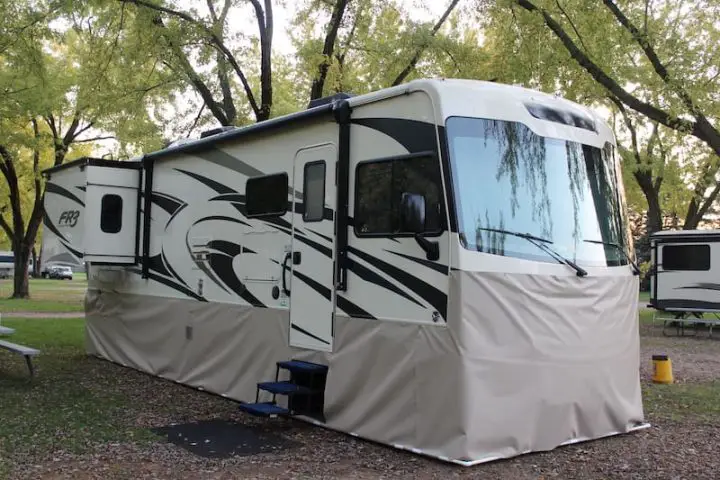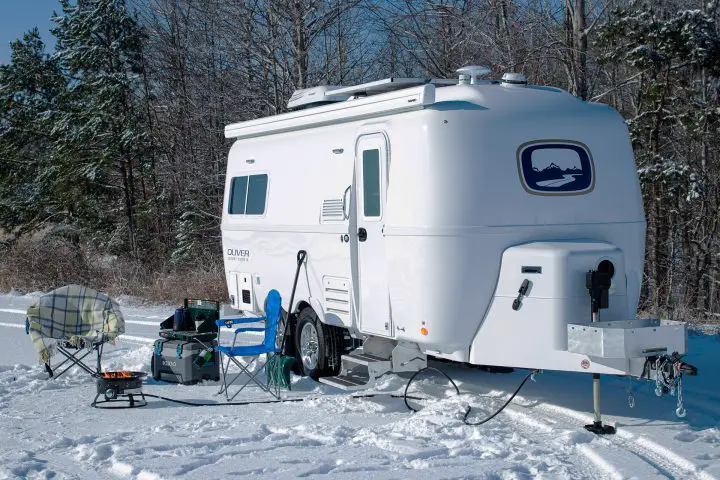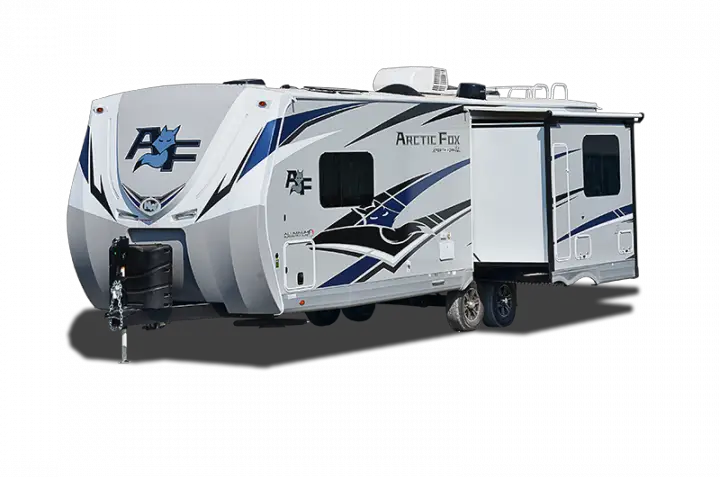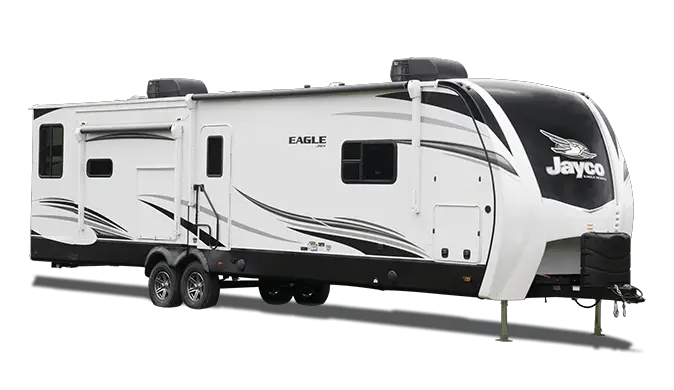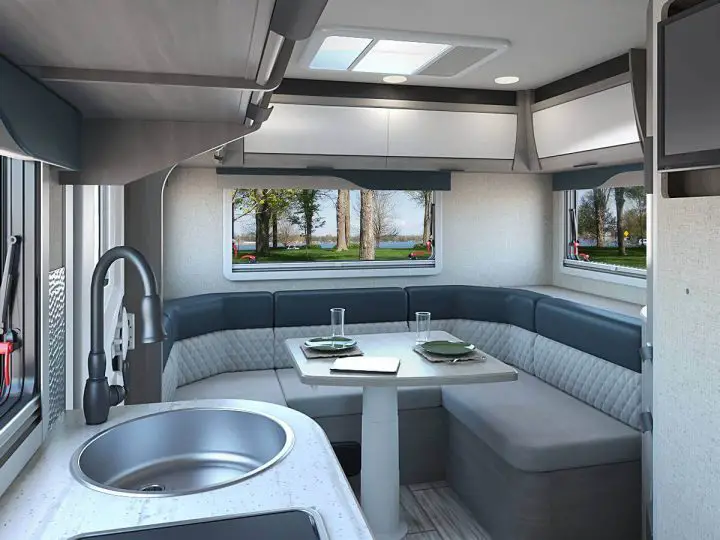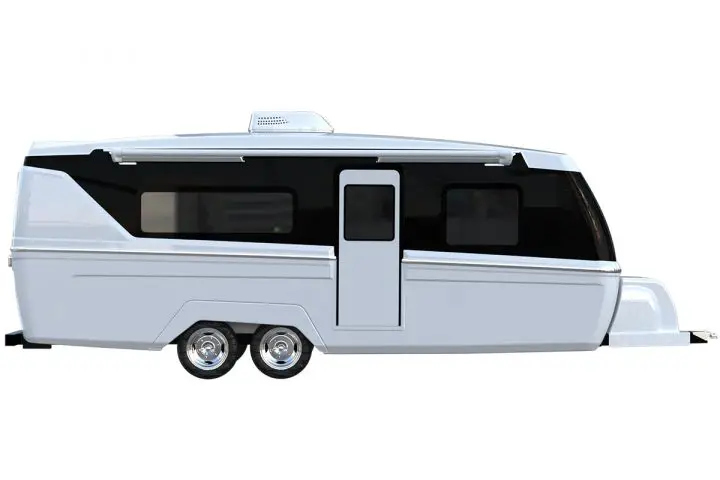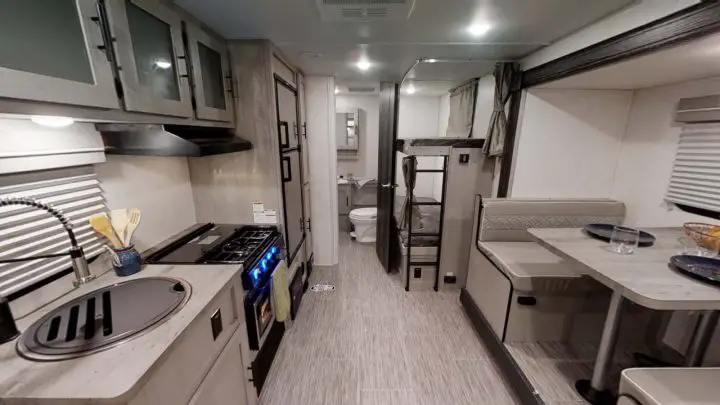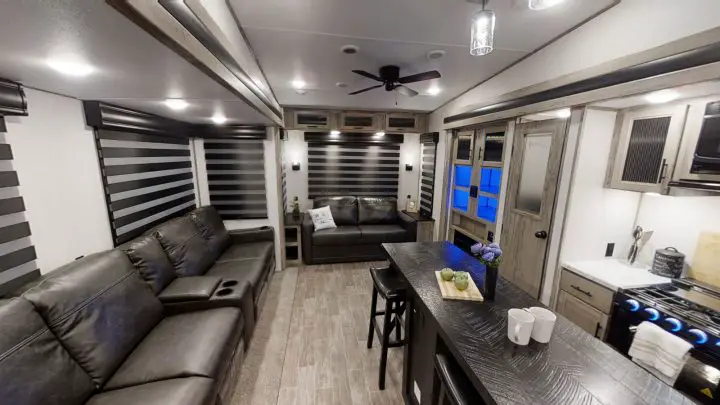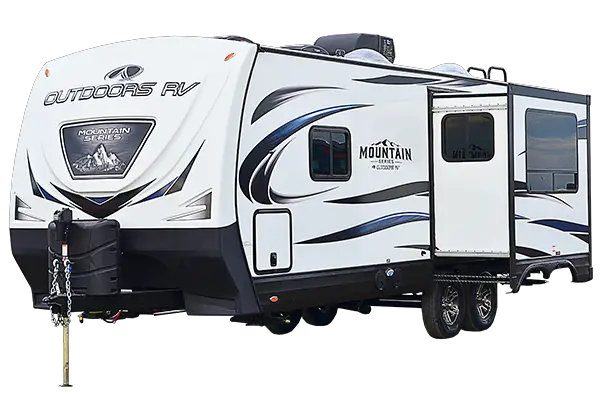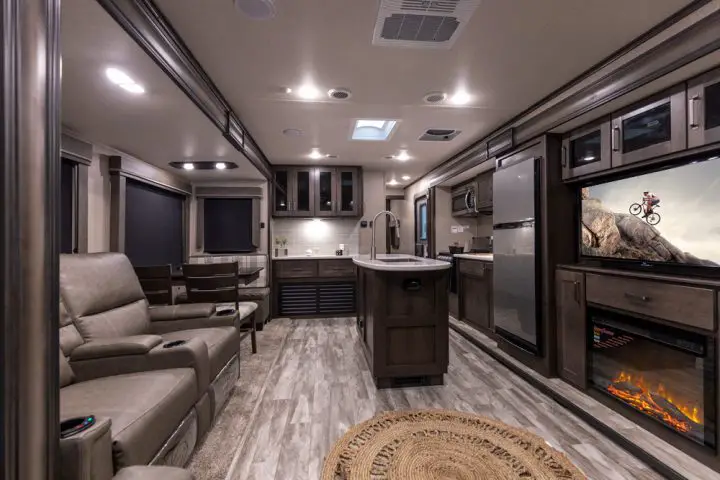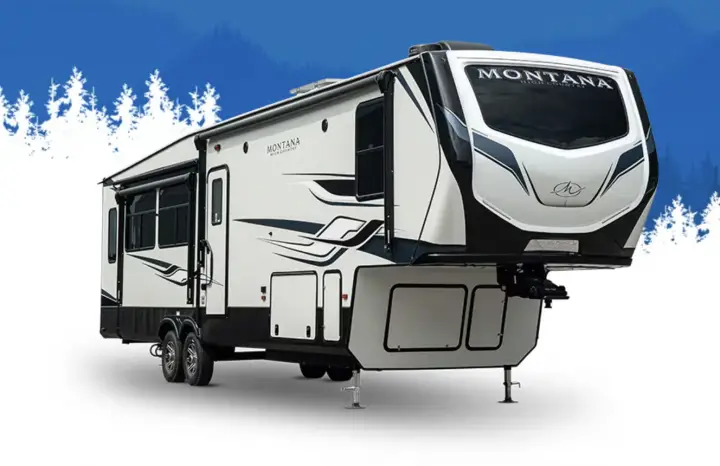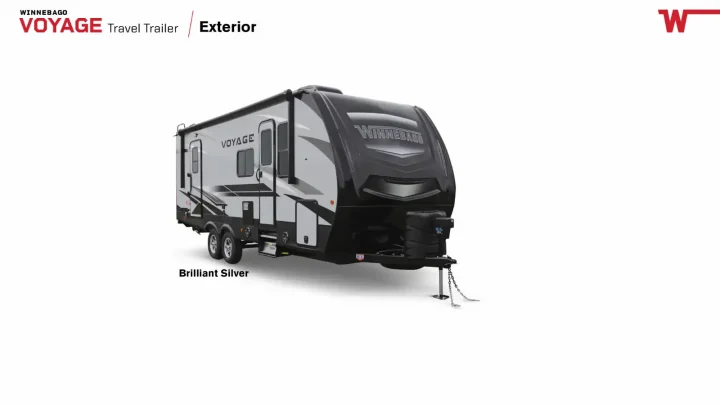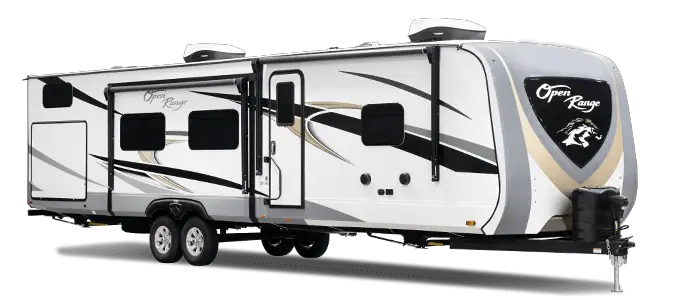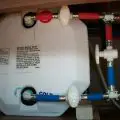Hey! This site is reader-supported and we earn commissions if you purchase products from retailers after clicking on a link from our site.
Do you dream of traveling year-round, totting your snowboard and snowshoes into distant spots in the backcountry? Maybe you dream of majestic frozen landscapes, snow-capped peaks, and campgrounds all to yourself.
Contrary to what many would have you believe, winter RVing does exist. But doing it successfully and enjoying the experience takes careful planning and specialized equipment.
So put your tire chains on, and grab the snow shovel (just in case). We’re going to tour some of the best four seasons travel trailers and look at what you need to do to enjoy yourself over the winter–without driving to Arizona or Florida with the rest of the crowd.
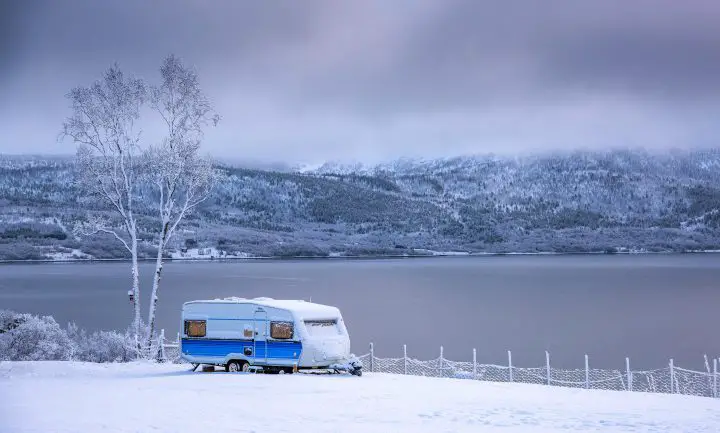
Table of Contents
- Buyers Guide for the Best All Season Travel Trailers
- 12 Best 4 Seasons Travel Trailer and Campers to Live In
- Oliver Legacy Elite and Legacy Elite II – Best Four Season Travel Trailers
- Northwood Arctic Fox North Fork Four Season Trailers
- Jayco Eagle
- Lance Camper Travel Trailers
- Northern-Lite Boreal 27FB – Luxury Fiberglass Four Season Travel Trailer
- Forest River IBEX Travel Trailers
- Forest River Cherokee Arctic Wolf Fifth Wheels
- Outdoors RV – Best All-Season Travel Trailers for Boondocking
- Grand Designs RV Reflection – Best Four Season Travel Trailers and Fifth Wheels for Luxury
- Keystone Montana Four Season Fifth Wheel Campers
- Winnebago Voyage Trailer
- Highland Ridge RV Travel Trailers
- What’s the Best 4 Season Travel Trailer for Full-Time Living?
- FAQs (Frequently Asked Questions)
Buyers Guide for the Best All Season Travel Trailers
Some readers may be asking–why on Earth would anyone want to camp in their RV during the winter? If you’re asking the question, there is likely no answer that will satisfy you. For you, heading south and enjoying the sunshine all year is the purpose, and your trailer is the solution.
But there are plenty of folks who love winter for everything it offers. The snow is beautiful, the backcountry is pristine and quiet, the landscapes unspoiled.
Campers, travel trailers, fifth wheels, motorhomes–there are as many camper designs as RVers to stay in them. So, of course, some of these folks will want to use them over winter. It’s just a matter of finding the suitable trailers that suit that purpose.
Whatever you want to stay in, you can do it year-round with a bit of effort. But it’s not a free ride, so make sure it’s something you really want to do. If you’re already dubious if it’s worth it, plot a course south to stay warm. That’s what most people enjoy most, after all.
What is a 4 Seasons Travel Trailer – Why Would You Want an All Seasons Camper?
There’s an old Scandinavian saying.
“There is no such thing as bad weather, only unsuitable clothing.”
This will undoubtedly ring true if you’re an experienced winter hiker or outdoorsman. You can layer up, and modern fabrics can insulate you against the harshest conditions.
This same principle applies to your travel trailer or motorhome. How many layers you will need to add to stay warm will depend on just how cold it’s going to get. You can add some basic layers to any RV, but you will reach a limit at some point.
Keep in mind that entry-level campers have little insulation to start with. You can add a skirt and window covers, but to stay any longer or get any colder, you will wish you had a four-season, well-built camper.
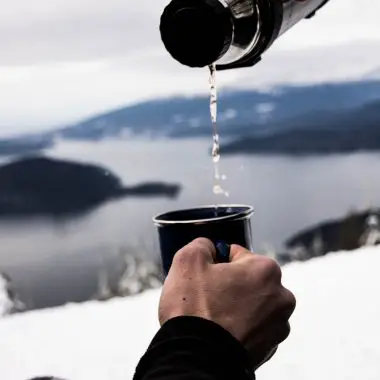
How Will You Use a Four Seasons Trailer/RV?
The first step to shopping for any home or vehicle is to carefully analyze how you will use it. Are you going to live in it or take the occasional vacation? When you stay in the camper, is it for a short-term getaway or a long-term road trip that lasts more than a few weeks? Or, are you looking to go full-time and make a big lifestyle change?
Pair these choices with an examination of where you want to set up camp. How much precipitation will there be, and of what type? Will ice be a problem? What–precisely–will be the average low and high temperatures you’ll be experiencing where you’ll be?
The bottom line is that many of us plan our RV life so that we’re avoiding snow and freezing conditions. If you plan to be a “snowbird” and fly south every fall, getting a four-season RV that can handle blizzard conditions might not be worth it.
The other side of that argument, however, is that there is really no downside to buying a well-built and well-insulated RV beyond the purchase price. If your choices come down to a slightly used top-of-the-line camper with thick walls and an enclosed and heated underbelly, or a brand new trailer with none of those features–you’ll probably be happier in the used camper for numerous reasons.
Winter Reality Check
Before you go full-in on living in your camper through a long, cold, and dark winter, sit back and research. Winter RVing isn’t for the faint of heart and probably isn’t a good place to begin the RV adventure.
Using your RV during the winter comes with a host of difficulties. Of course, there are plenty of rewards, so don’t be put off too quickly. But it’s not as easy as staying warm in a sticks-and-bricks home.
No matter how well they built an RV, it will never be as well insulated from the cold as a permanent structure. Being off the ground, cold air flows all around.
The propane furnace is enough to take the edge off, but there are problems with that, too. Before you get anywhere near-freezing temperatures, you will wind up doubling up on heaters and piling on extra blankets.
Problems start doubling up once you get to freezing (32º F or 0º C) or colder temperatures. Now any exposed plumbing can start freezing if you don’t take some precautions.
It’s all doable, but it’s much more effort than summer camping. The campground’s water might not even be turned on, meaning you’ll be limited to how much water you can use. With everyone drawing so much power for space heaters, you might find breakers popping and occasional outages. You might not want to leave your sewer hookup open since freezing temperatures could freeze the plumbing and possibly bust the valves.
So, with all of that in mind, is winter camping even worth it? Most people do not use their RV in the winter, with snow on the ground and the cold creeping in. But others want to travel to enjoy winter sports and the quieter off-season. So it is definitely worth it for RVers who want to use their campers year-round.
Keep this in mind as you read on. How much effort (and money) you want to put into making your camper all-weather ready is an individual choice. Some people just want peace of mind that their camper will be as they left it when they put it away for fall. Others are looking to live in it full-time all winter long, blizzards and all. So which describes you?
Types of Four-Season RV
Any recreational vehicle can be equipped for all-season living, but never assume that they leave the factor designed to do that.
Most of the differences that make a four-season trailer an all-weather warrior revolve around quality–thicker walls, better insulation, better protection of tanks, and plumbing. Hence, there is a connection between the quality of the brand and the overall cost of the trailer when it comes to outfitting it for winter weather. Building a trailer that can handle harsh conditions costs money and adds weight to the rig.
In other words, you get what you pay for. At least when it comes to four-seasons campers.
An inexpensive and lightweight Coleman camper is unlikely to have much insulation. The underbelly is probably exposed, and while you could technically camp in it over winter, you’re going to have a lot of trouble keeping it–and yourself–warm.
So, when shopping for RVs and travel trailers with winter in mind, you’ll have the least luck with budget and ultra-lightweight models. On the other hand, high-end or luxury models will have more options and better construction. They’re also more likely to come with all-season packages that include things like beefed-up insulation, larger furnaces, and heated tanks.
When shopping for an all-season RV, you can take your pick of style.
- Truck campers
- Small towables like teardrops
- Travel trailers with one or two axles
- Fifth-wheel travel trailers
- Class C motor homes
- Class B vans
- Class A four-season motorhomes
Some of these classes lend themselves to all-seasons camping better than others. Truck campers and teardrops, for example, are small and easy to insulate but lack much in the way of heating options and systems for a living.
On the other hand, a fifth-wheel trailer or a Class A coach is likely to be luxurious, to begin with. It will come with many options that make winter living easier, like multiple heat sources and enclosed underbellies.
What Makes a 4 Season RV Special?
There are plenty of people staying in regular campers year-round. So what makes a four-season camper any different from a three-season model? First, it’s essential to realize that there are no clear definitions for any of these terms in the RV industry – a lot of it is left up to the RV manufacturers and their marketing teams.
With that in mind, if you want a serious trailer that can take on a cold winter, it’s up to you to find it. Do your research and know what you need to do. Know what important materials and construction features to look for and how important RV insulation is to an all-weather camper.
You’ll also want to consider other cold-weather factors, like tire requirements, battery types, and battery charging and use profiles. The electronic braking system on four seasons RV trailers are crucial for better control should you wind up driving through snow and ice.
Finally, no matter how well-built your trailer nor how prepared you are, living in the camper in cold weather will present a whole new set of challenges. You’ll have to take special precautions to ensure that none of your pipes or water hoses freeze up. You’ll want to think about your sewage hose and how to keep it from freezing into the dreaded “poopsicle.”
Inside the camper, you’ll experience a lot of condensation on the walls and windows, leading to moisture problems. Be ready to run dehumidifiers and add even more insulation to keep the interior dry. Mold and mildew can form quicker than you can imagine.
Specific Features to Look For in a 4 Seasons Camper
Since the marketing phrases, stickers, and manufacturer’s packages seldom provide much detail, the best way to pick a great year-round camper is to know what you’re looking for. Here’s a list of the specific items you should think about when comparing different campers.
- Insulation
- Double-pane windows
- Enclosed, insulated, and heated underbelly
- Plumbing that is protected and makes winterization easy
- Appropriately sized heating and cooling with ducting
All Season Travel Trailer Insulation
The number one thing that sets all-weather RVs apart from their summertime counterparts is how much insulation they have. But insulation isn’t something you can see in a finished RV without taking it apart, so it can be tricky to figure out how well one is insulated.
Travel trailers are notoriously poorly insulated. Remember, every pound counts when towing. So if you’re not staying in your rig during the winter, does it even make sense to add weight to it to make it more comfortable during those extreme weather periods?
Good insulation is not just helpful during the winter, though. Sure, its purpose is to trap the warm air you make with your furnace and to keep you warmer. But the same rules apply during summer–the better your RV insulation, the more cold air from your air conditioner will stay inside, and the better the AC will cool.
For this reason, insulation is important in any RV. Even if you have no interest in living on wheels during freezing temperatures, you might be interested in spending a summer in Arizona or Florida. If that’s the case, getting the absolute maximum cooling out of your air conditioning will definitely interest you.
Understanding Insulation R-Values and How They Apply to RVs
Types and thicknesses of insulation are rated by their R-values or their resistance to conductive heat flow. Theoretically, you can calculate the total R-value of a wall by adding up the R-values of the component parts. However, air gaps and compressed materials can affect the results considerably.
You’ll often see RV makers marketing radiant barriers as a form of insulation. These are reflective materials that re-emit heat instead of absorbing it. According to the US Department of Energy, radiant barriers have no R-value at all. You can learn more about insulation materials and radiant barriers from the US Department of Energy’s website.
The bottom line is that the advertised R-values some RV makers use are questionable. For example, compiling multiple types and layers of insulation into the thin walls of RVs may not be as effective in reality as it is on paper. So take R-value ratings published in sales brochures with a grain of salt, and don’t get hung up on the actual math.
Windows for Thermal Efficiency
As with a traditional home, your windows’ quality and installation will significantly affect how well your living space retains heat. The best solution is to use only dual-pane windows with a high thermal efficiency rating. This is one of the most obvious things you can check for when shopping for a new camper.
Enclosed, Insulated, and Heated Underbelly
When it comes to the underbelly, summer RVing carries no risks. You’ll be worried about the boiling sun from above and not so much about trouble from below. The opposite is true in the winter, however. The insulation on the top and sides will help keep the living space warm, but failure to insulate the underbelly can be a big mistake.
RV trailer designs come with enclosed or open underbelly. An open underbelly does not protect the floor, meaning all of that circulating cold air will make it doubly hard for you to heat the camper. It also puts your plumbing and tanks at risk, some of which are invariably located below the camper. If you allow that stuff to freeze, life will get pretty unpleasant. Burst pipes and leaking holdings tanks do not make for a romantic vacation or relaxing getaway.
Enclosed underbellies do not necessarily fix all your problems, however. Some are enclosed but with very thin siding. That makes it possible to heat and protect, but not ideal. Better yet are those with enclosed and insulated areas below. With added heaters, this can make a four-season solution that will really work.
Plumbing for 4 Seasons Campers
You need to know where your plumbing is before experimenting with winter camping. Is it in the enclosed underbelly? Is it out in the open? Is it divided between the living spaces (heated) and exterior spaces (possibly freezing)?
As a general rule, if you can see your tanks, they aren’t protected well enough from freezing temperatures. Completely enclosed underbellies are best, with the tanks well insulated and protected from all of the elements. Even still, freezing temperatures can and will get in. This is why most of the best four-season travel trailers will have heating elements to protect all of the plumbing and tanks.
The hookups for an all-season camper deserve extra scrutiny. In keeping with the theme above, you must protect all hoses and pipes at a minimum. If you plan to spend time living in the RV during cold spells, invest in heated water lines and tank heaters.
Another thing that you might consider is your hot water heater. Remember, not only do you want a hot water tank capacity that will allow you to keep enough warm water while living aboard, but you’ll also want to make sure it’s installed with a bypass and drain, ready for using an RV winterization kit.
Not all features of an all-season RV will be about living on it. It’s also important to keep this little thing in mind when storing the camper over winter. Anything you can do–or the manufacturer can do–to make winterization easier will pay dividends down the road. You’ll appreciate it every year if the process is made easier by quick connections and sound system design. You’ll also be more likely to take the trailer out for a trip during the winter if you know the chores of putting it away are easy.
Air Conditioning, Heating Furnace, and Ducting
One often-overlooked factor when outfitting an all-season camper is your RV furnace needs. A lot is made of the BTUs of the furnace or the size of the air conditioner for four seasons RV living, but few discuss a more critical factor – ducting.
Ducted furnaces are far superior because they spread that heat out over the entire trailer. Good quality ducting makes it happen because you don’t want the air to lose its warmth while traveling to the next room. The same rule applies to AC duct – you want it to keep cool and distribute that sweet cool air throughout–not in one spot.
During cold snaps, it’s also important to realize you’ll be running your furnace quite a bit – possibly even constantly. A standard 20-pound propane tank isn’t going to last very long. Many RVers upgrade to a 30, 50, or even 100-pound tank if they plan on over-wintering.
Preparing for Hot and Cold Weather
No matter how all-weather compatible your RV came from the factory, you can always make it better. Many people camp successfully in three-season campers by taking lots of precautions and installing as much protection and modifications as possible.
Start your research early, regardless of how well-protected your travel trailer is. If there’s cold weather approaching, have a plan in advance. And remember, if it’s going to get around or below freezing and you aren’t keeping it heated, you’ll have to winterize it.
Winterizing an RV involves removing all of the water from the pipes and tanks that might freeze. In some cases, you can drain the system, but you’ll often use a pink-colored propylene glycol anti-freeze available at most camping, big box, and RV suppliers.
No matter what sort of extreme temperature you’ll be facing, you can’t count on your one furnace or air conditioner alone. Even if it is sized correctly, most cannot handle the extremes. For example, put an ordinary camper in direct sunlight on a 95-degree, 95-percent humidity day in Florida, and the inside will start getting so hot that the AC can’t keep up. Likewise, when the temperatures dip into the single digits, most furnaces will have to run constantly.
For this reason, do everything in your power to plan for cold or hot weather and plan accordingly.
Tips for Cold Weather Camping
Wondering how to prepare an RV for winter? Start with a walk-around of your rig and look for ways to keep the heat in.
RV Skirting
If you aren’t traveling–or at least not moving much–you cannot ignore the benefits of RV skirting. Skirting is one of the best ways to guard against the risks of freezing temperatures. It will keep your plumbing safe and your interior cozy.
Skirting is just material that seals the air gap beneath the camper. It keeps the cold air and wind out from under the trailer and traps warmer air underneath. If you’re living in the camper and running the heat during the winter, you probably won’t need to winterize at all if you have good-quality skirting installed.
You can add skirting material to any travel trailer or RV. Even if your rig came with an upgraded winter package, the skirting would help keep you more comfortable and make your furnace run more efficiently. Skirting can be made of heavy insulated fabrics or insulating foam boards. Many DIY project plans are available online, or you can hire someone to make a custom-fit solution for your rig. EZ Skirt is one popular option.
Insulated Window and Hatch Covers
Another item worth consideration for winter is insulated hatch covers and window dressings. Even with double-pane insulating windows, covers can help you keep the heat in and get more useful BTUs from your furnace.
- Fits standard 14 RV vents
Prices pulled from the Amazon Product Advertising API on:
Product prices and availability are accurate as of the date/time indicated and are subject to change. Any price and availability information displayed on [relevant Amazon Site(s), as applicable] at the time of purchase will apply to the purchase of this product.
Electric Space Heaters to Help Your Furnace
Space heaters can help you heat those cool corners of the RV that never seem to stay warm. For example, they’re great ways to add a few degrees to the master bedroom. Always use caution when adding space heaters, as you’ll quickly overload your camper’s electrical circuits. This model from Caframo has safety cutoffs and is designed so you can’t knock it over.
- Wattage: 1500.0 watts
Prices pulled from the Amazon Product Advertising API on:
Product prices and availability are accurate as of the date/time indicated and are subject to change. Any price and availability information displayed on [relevant Amazon Site(s), as applicable] at the time of purchase will apply to the purchase of this product.
Heated Hoses and Tank Heaters
No matter how well insulated your pipes are, you will have to protect the hoses if you want to use your hookups. Heat tape is one practical option. You also want to use lots of insulating tubing to protect water lines. Another option is a heated hose, like those made by Caframo.
- Ideal for water line freeze protection down to -20 degree F (-28 degree C) with an energy saving thermostat
Prices pulled from the Amazon Product Advertising API on:
Product prices and availability are accurate as of the date/time indicated and are subject to change. Any price and availability information displayed on [relevant Amazon Site(s), as applicable] at the time of purchase will apply to the purchase of this product.
- 24Ft x 120V x 7W/ft.
Prices pulled from the Amazon Product Advertising API on:
Product prices and availability are accurate as of the date/time indicated and are subject to change. Any price and availability information displayed on [relevant Amazon Site(s), as applicable] at the time of purchase will apply to the purchase of this product.
If your RV’s tanks don’t have much protection or are prone to getting too cold, consider installing a heated tank blanket. These 12-volt heating pads tape onto the sides or below a tank to keep its contents above freezing.
Research Year-Round Parks
Finally, don’t overlook the planning component of winter RVing. Are there RV parks open year-round? The answer may be no in areas that experience brutal winters, especially mountains. At the very least, you’re likely to find far fewer options during the off-season.
Tips for Hot Weather
Ironically, the tips for surviving brutally hot summers aren’t very different from making it through a frigid winter. The goal is to protect your RV from extreme temperatures, and the solution to doing so is to insulate it well. A well-insulated camper will take longer to heat up in the sun in the summer. Also, when the air conditioning is running, that appliance will run more efficiently and effectively if the cool air stays inside.
Skirting and insulated reflective window covers are a good start. You may also want to pay attention to where you park in hot weather–anything you can do to block the direct sun from falling on your RV will reduce the temperatures inside.
Don’t assume this doesn’t matter because you have an excellent AC. Air conditioners will reduce the temperature, but only to a certain extent. For example, if you park two identical campers with identical air conditioners next to one another, one in the sun and one in the shade, the one in the shade will always be cooler.
In wide-open spaces, consider awnings or tarps–anything to keep the sun off. What about the color of your top–does RV roofing matter? If it’s black or dark-colored, you bet it does. The brighter white and more reflective you can make the roof area, the less of the sun’s heat it will absorb.
12 Best 4 Seasons Travel Trailer and Campers to Live In
Oliver Legacy Elite and Legacy Elite II – Best Four Season Travel Trailers
Oliver makes double-hulled fiberglass shell travel trailers. They’re sharp-looking and built exceptionally well. They roll off the factory floor with tons of options and packages, so you can outfit your “Ollie” to suit any adventuring style. The Legacy Elite is a single-axle, 5,000-pound, 18-foot 5-inch smaller trailer, while the Elite II is a tandem-axle, 7,000-pound, 23-foot 6-inch camper.
Like all cold-weather RVs, a robust heating system is at the heart of Oliver’s winter camping prowess. The 11,000 BTU furnace has dedicated ducts–so it’s the perfect size for the camper. The company also installs a radiant barrier in the camper that includes a polyethylene bubble, a radiant barrier, a vapor barrier, and an air gap–all of which make these fiberglass campers some of the best-insulated models you’ll find.
Most plumbing and tanks are stored between the two fiberglass skins for maximum protection from the elements. Couple this robust design with the standard double-pane windows, and you’ve got a little camper that you can use year-round.
That double hull design helps out during summer, too. The same insulation that keeps you warm in arctic conditions will work just as well in the baking Florida sunshine. And it means that the standard Dometic Penguin roof-mounted air conditioning will work at its absolute peak efficiency.
While the winter camping possibilities make the Oliver interesting, it’s worth noting that it’s also one of the best-built campers on the market. Every camper they make undergoes extensive quality control.
Oliver does not sell through dealers to reduce costs. To see one in person, visit the Oliver website, where you’ll be matched with an owner in your area for a tour. You won’t meet a salesman in the process–just real owners with real campers and their honest opinions of them. You can also schedule a tour of their factory in Tennessee if you’re interested.
Northwood Arctic Fox North Fork Four Season Trailers
Northwood Manufacturing makes a full line of travel trailers, fifth wheels, lightweights, and truck campers. The Arctic Fox North Fork travel trailer is an all-season rig available in floor plans ranging from 22 to 32 feet long.
Of the many standard features on the North Fork lineup, you’ll get a rugged off-road chassis made of thick-walled aluminum, high-density foam block insulation, heated tanks, a semi-automatic winterization bypass system, and frameless thermal pane windows. The insulation in the entire camper is rated for all conditions, with an R-18 ceiling and R-15 reflective insulation in the roof.
While the standard specs are impressive, a few add-ons and optional upgrades will turn your Arctic Fox into a winter wonderland home. Tank heaters and an upgraded furnace and AC are wonderful options. Even the standard furnace and AC come with dedicated ducts, so upgrading is an easy task.
If you’re in the market for a cold-weather home that roams with even more space, the Arctic Fox Grande Ronde is the fifth-wheel version of the same camper. They range in length from 27 to 35 feet long. https://northwoodmfg.com/5th-wheels/arctic-fox-grande-ronde-5th-wheels/
Jayco Eagle
The Eagle range of travel trailers is a 40-foot luxury camper from Jayco available in several different layouts.
The Eagle trailer includes many upgrades and elements that make it suitable for winter living. All campers come standard with “Climate Shield” weather protection, which Jayco claims to be tested to zero degrees. The system includes a fully enclosed and heated underbelly, a huge 35,000 BTU furnace, double fiberglass insulation on the ceiling and floor, a double-sided radiant barrier on the roof, floor, and cap, and PEX plumbing.
Lance Camper Travel Trailers
Lance makes a full line of truck campers and travel trailers. Their trailers range from the 14-foot 10-inch 2,600-pound 1475 to 2465, their 24-foot 11-inch 6,830-pound flagship.
The Four Seasons Comfort Technology Package will add year-long use options to your Lance camper. It includes a ducted heating system, a water heater bypass, an insulated hatch cover, and a fully enclosed underbelly.
Lance’s designs and layouts are well thought out and functional. These aren’t luxury campers–but they aren’t cheap entry-level models, either. Instead, you have a mid-range travel trailer that can travel in all four seasons in comfort. It’s especially nice to see that Lance is putting their designs into smaller packages, and the layout of their ultra-small 1475 is very attractive.
Northern-Lite Boreal 27FB – Luxury Fiberglass Four Season Travel Trailer
Norther-Lite is a leading manufacturer of truck-bed campers. Their business and designs are built on providing all-weather and all-season camping options to adventure travelers. Their new 23-foot-long Boreal travel trailer carries this legacy with its sleek fiberglass design and great amenities for extreme weather camping.
The Boreal has a 35,000 BTU furnace and a 13,500 BTU air conditioner with a heat pump. It’s a big trailer, with a GVWR of 8,520 pounds. The fiberglass shell is leak-proof and seamless, and the camper comes with an outstanding six-year warranty.
A few of the excellent four-season features included in every Northern Lite camper include R7-rated insulation, thermal pane windows and skylights, heated tanks, and marine fabric headers. According to their site, their campers have been tested to temperatures as low as -20 degrees Celcius!
Forest River IBEX Travel Trailers
The Forest River IBEX line of travel trailers focuses on full-featured models that are smaller and easy to tow with modern SUVs. However, this doesn’t mean they’re ultra-light or limited on luxuries. Instead, these campers have everything you might need for four-season camping wrapped in a tidy package.
Among the many features you’ll find packed into the IBEX trailers include:
- Azdel construction
- Solar panels, controllers, and a 1,000-watt inverter
- All-terrain tires and high ground clearances
- Central vacuums
- Rhino-rack RTV tracks
- Panoramic windows
- Large stainless steel appliances and outside cooktop
The cold weather package includes a heated and full-enclosed underbelly, tank heaters, and an enclosed termination system.
You can pick IBEX floorplans from the 24-foot 19MBH to the 30-foot 24MTH. Their designs are unique, featuring convertible beds, garages, bunk beds, and pass-through storage options.
Forest River Cherokee Arctic Wolf Fifth Wheels
The Arctic Wolf line of lightweight fifth-wheel trailers comes packed with remarkable living space and year-round living features. These campers have layouts that span from the 261RK (11,525 pounds and 30 feet long) to the 3990SUITE (14,080 pounds and 43 feet long).
The Elemental Protection Package includes almost everything you’d want to have for cold-season living.
- Upgraded two-inch thick walls with block foam insulation
- High-efficiency 35,000 BTU furnace
- Central air conditioning 15,000 BTU
- Armored underbelly with forced hot air around all tanks
- 5,200 BTU electric fireplace with fans
- Non-conductive wood roof and floors
- Oversized fans attic fan for better airflow
- Super H duct pattern for maximum efficiency
- Seamless roofing membrane
- 50-amp shore power
If you like the looks of the Arctic Wolf but aren’t in the market for a fifth wheel, another option is the Alpha Wolf travel trailer. These smaller campers incorporate many–but not all–of the outstanding winter features found in their larger sister ships.
Outdoors RV – Best All-Season Travel Trailers for Boondocking
Outdoors RV produces its campers with the explicit goal of creating what they call “no boundaries camping” in the mountain states of the western US and Canada. They also proclaim to enjoy all-season camping and design their trailers specifically for the task.
Outdoors RV makes a solid range of travel trailers and fifth wheels, with layouts to suit any family. The Creekside trailers are under 6,000 pounds at 20 feet long, the Timberridges are from 6,000 to 7,750 pounds, and the Blackstone trailers are over 7,000 pounds and up to 31 feet long. The Glacier Peak fifth wheels are 35 feet long and 10,225 pounds.
They call their winter package “Mountain Tough.” These upgrades come standard in every camper, which is a nice touch, especially if you’re in the market for a second-hand trailer. It includes “Mountain Extreme” thermal pane windows, triple-layered roof insulation, a fully-enclosed underbelly that is heated and insulated, and the reflective foil on all floors and roof areas (including the slide-outs) with double wraps on tanks.
There are many nice finishing touches on an Outdoor RV that really set them apart. For example, all exterior access panels, like the outdoor shower and luggage compartments, are thicker than other manufacturers because they’re made with one-inch-thick insulation. The company even includes thermal pillows to fill bedroom vents, a nice touch.
To wrap it all up and keep you cozy, Outdoor RV installed extra-large furnaces that are 15 percent larger than competitors. They even include the Norcold refrigerator’s cold weather kit, meaning you won’t have any trouble down to at least 0º Fahrenheit.
Grand Designs RV Reflection – Best Four Season Travel Trailers and Fifth Wheels for Luxury
Grand Designs has built an excellent reputation with its luxury travel trailers and fifth wheels. These high-end towables come with a range of features that allow them to excel as winter getaways. However, the best protection from the elements comes from the Reflection brand, available in both trailer and fifth wheel versions.
The Reflection trailers come with Grand Designs’ Arctic 4-Seasons Protection Package. This extensive weatherproofing works from the ground up to make winter living more comfortable.
- 35,000 BTU furnace
- Double-insulated front cap and roof
- Insulated slide-out floors
- Heated and enclosed underbelly with circulating heat, including dump valves
- Foil insulation under tanks
- “EZ” winterization valve
- 12-volt tank heat pads
- Heated storage areas
Keystone Montana Four Season Fifth Wheel Campers
Keystone makes a vast variety of RVs–travel trailers, fifth wheels, toy haulers, and destination trailers. The product lines span every budget and style of RV, from entry-level three-season campers to fully-decked-out luxury models with every bell and whistle.
As such, it can be overwhelming to sort through the Keystone website and figure out the differences between model ranges. Many mid-range models can be upgraded with the “Four Season Living Package,” but this is found standard on higher-end models.
If you’re in the market for a fifth wheel, it’s hard to go wrong with a Keystone Montana. The Montana High Country comes standard with the Four Season Living Package, 12-volt heat pads on the tanks, and foil insulation around the floors, underbelly, and front cap. The underbelly is enclosed, heated, and insulated–and the convention center and dump valves are protected too. The rig is tested and approved for use down to 0º Fahrenheit.
Winnebago Voyage Trailer
The top-of-the-line Voyage travel trailer from Winnebago is loaded with features that will make you want to travel all year long. It’s built for extended adventures in mind, with long-term living solutions like spaces pre-built for washers and dryers, extra storage, and full-sized refrigerators.
For cold weather, Winnebago includes the Comfort Tech Package. This includes laminated block-foam sidewalls, “Extreme Weather” radiant foil wrapping, insulated heating ducts, heated tanks, and an enclosed underbelly. In addition, the Explorer Package adds the 30,000 BTU propane heating furnace.
The Voyage trailers range from 27-feet 9-inches to almost 39 feet long. GVWR is 11,000 pounds or slightly less, depending on the floor plan.
Highland Ridge RV Travel Trailers
Highland Ridge makes a huge lineup of travel trailers and fifth wheels for every traveling style and budget. But, as with most manufacturers, the best amenities for winter and four-seasons camping are in top-of-the-line models like the Open Range, Mesa Ridge, or Silverstar trailers.
You’ll find a mandatory Four Season Package on all of these branded trailers. This includes R-38 foil insulation in the ceiling and underbelly, R-9 block foam insulation in the walls, double-insulated baggage doors, and an enclosed underbelly with ducted heat. In addition, all valves and flushes are enclosed in an exterior docking station. And, of course, you get a high-performance furnace.
The walls of the Highland Ridge trailers are also noteworthy since they are made with “Tuffshell” composite construction. They are vacuum-bonded with heavy-duty fiberglass and filled with foam insulation, which makes the RV very strong but inherently well-insulated.
What’s the Best 4 Season Travel Trailer for Full-Time Living?
Now that you’ve seen some of the options, it’s probably pretty apparent that the best four season campers are also some of the best campers. High-end, top-of-the-line models give you the most choices–they provide all of the amenities you need for long-term living and the quality components and construction that will help keep you warm.
Yes, you can occasionally winter camp in any camper. But if you want a serious, full-time living situation that will keep you warm, safe, and comfortable, then a factory-finished four seasons travel trailer is the way.
Related pages:
- Buying an RV
- Used RV Buying Guide: How to Buy an RV
- Buying a New RV: Things to Consider
- How to Get Comfortable Driving Your New RV
- Best Luxury Travel Trailers
- Best Lightweight Travel Trailers
- Best Travel Trailers
- Best Dry Camping Travel Trailers
- Best Bunkhouse Travel Trailers
- Best Fiberglass Travel Trailers
- Best RV Accessories
- Best RVs for Full-Time Living
- A Look at the Cost of Living as a Full-Time RVer
- Living in an RV on Your Property: What States Allow it? A Full List
- How to Prepare for Full Time RV Living
- Biggest Challenges of Living in an RV Full Time
FAQs (Frequently Asked Questions)
What travel trailers are 4 season?
Travel trailers and campers are often rated as three- or four-season or “all-weather.” You might even see it advertised with add-on packages from the manufacturer. Unfortunately, these ratings don’t have a standardized meaning. That makes it challenging to figure out exactly what a 4 season travel trailer is and whether or not it’s appropriate to your purpose.
What are the best four-season campers?
The best four seasons campers have an extensive list of features designed to keep the camper warm during extreme cold snaps. Features like heated tanks, insulated roofs, and walls, double-paned windows, and heated enclosed underbellies make huge differences. You’ll also want to look for RVs with larger-than-average furnaces and extra-efficient heating appliances.
Which travel trailer is best for cold weather?
Many campers are rated for four seasons or all-season comfort, but no industry standard applies to these terms. The only way to evaluate which camper is best is to break down the temperature ranges you wish to travel in and see what features you will need. For extremely cold weather protection, you’ll want to invest in something built from the ground up for those conditions, like the Outdoors RV Mountain Series, or the Oliver Legacy Elite II.
What is the most reliable brand of travel trailer?
When researching the most reliable and best-built brands of trailers, three names always come up.
Grand Designs RV is a US-maker of travel trailers. Their delivery process includes an extensive multi-point inspection and outstanding after-sales support. Secondly, Airstream makes the iconic “Silver Bullet” trailers. They have a legendary reputation for outstanding quality, but that also means that these head-turning travel trailers can be expensive compared to other options. Finally, Oliver makes double-walled insulated fiberglass trailers that are rated highly reliable.



